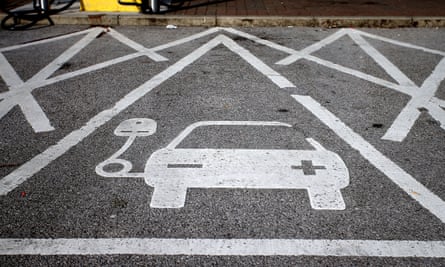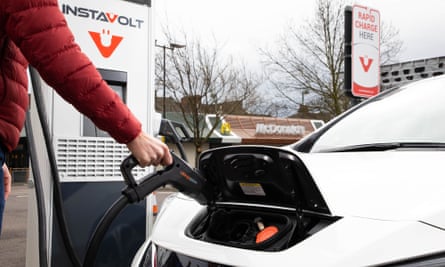‘Why did it take nine hours to go 130 miles in our new electric Porsche?’
A couple from Kent have described how it took them more than nine hours to drive 130 miles home from Bournemouth as they struggled to find a working charger capable of producing enough power to their electric car.
Linda Barnes and her husband had to visit six charging stations as one after another they were either out of order, already had a queue or were the slow, older versions that would never be able to provide a fast enough charge in the time.
While the couple seem to have been “incredibly unlucky”, according to the president of the AA, Edmund King, their case highlights some of the problems that need ironing out before electric car owners can rely on the UK’s charging infrastructure.
The couple, who love their new fully electric Porsche Taycan 4S, which has a range of about 250 miles, contacted the Guardian to describe how difficult it is to recharge a car away from home. Their journey would have taken two and a half hours in a conventional car, they say.
The pair are not the first owners who love their electric cars to complain that the UK’s charging network is poorly maintained, complicated and hugely difficult to navigate via its various apps and payment systems.
The latest electric cars require fast 50kW-100kW chargers to refill on the go but they are hard to find and are often out of action.
Their journey shows the scale of the challenge the government faces if it is to have a working infrastructure in place ahead of its ban on new petrol and diesel cars in 2030.
After a tour of several chargers, they were left wondering if they might have to stay the night in a hotel
Linda Barnes says they knew they would have to stop for a fast charge on the way home but were unprepared for what happened next.
“We left Bournemouth with 45 miles of range left and followed the car’s navigation system to the nearest fast charger, plugged it in but nothing happened,” she says. “A parking attendant told us it had been out of action for weeks.”
After a tour of several chargers, they were left wondering if they might have to stay the night in a hotel. A nearby Porsche garage with a slow charger gave them a free boost to get them to the next motorway services. When they arrived there, a woman who was using it told them she had only got it working by calling the helpline and that the call centre was about to close.
At their next stop, there was a queue to use the 7kW slow charger, which was working but came with a “distinctly unhelpful” 45-minute time limit, at which point another driver suggested a nearby hotel that had charging points.
Rather than risk driving there and use up more power, the couple phoned, only to be told by staff that they had no idea what type it was or if it was even working.
When they finally got to a working fast charger at a motorway services – via two more that were not operating – they were met with eight shiny Tesla chargers but discovered they were out of bounds because they are only available to the brand’s owners.
Fortunately, there was another fast charger that was available and they were finally able to get enough power to get home with only 11% battery power to spare.
Linda says the sense of relief was enormous. “We ran through the entire gamut of emotions in those nine hours – resignation, range anxiety, annoyance and disbelief that this was happening – and finally elation when we realised we’d get home,” she says.
“At one point I thought we might have to spend the night in the motorway service area. We would have stayed in the hotel if it hadn’t been the night that the second lockdown came into force.”
 View image in fullscreenSome motorway services have electric charging points – but not all are operational. Photograph: Peter Byrne/PA
View image in fullscreenSome motorway services have electric charging points – but not all are operational. Photograph: Peter Byrne/PA
Thinking that they had just been unlucky on their first outing, the next day Linda’s husband drove to their nearest town where there are three charging points in a car park. None were working.
“He then drove to a local pub where there is one in the car park – that was not working, either. Undeterred, he drove to the local BP fuel station but, sure enough, that was not functioning. There was no helpline number on the charging point and the assistant in the service station couldn’t help and said it was nothing to do with them.”
Linda says she now knows why most drivers charge their cars at home overnight and avoid using the public network. “Our car is lovely to drive and electric cars are the future. However, someone needs to get a grip of the charging infrastructure,” she says. “On the plus side, we have discovered that electric car owners are a helpful bunch and everyone we met tried to help.”
The AA’s King, a keen electric vehicle driver, says the couple were very unlucky with their first non-home charging experience: “This couple are very lucky to have a Taycan, which is the best electric vehicle I have ever driven. For most electric vehicle drivers, charging at home and at work gets them where they want to go and back.
“However, the reliability and availability of public charging does vary, with much criticism aimed particularly at charging on some motorway service areas but things are fast improving.”
He cites companies such as Gridserve, which has a state-of-the-art charging station near Braintree in Essex, and InstaVolt, which has won three customer awards this year for the reliability of its 500-strong rapid charging network.
“Electric vehicle consumers want more interoperability, more chargers, greater reliability and a contactless experience. To really help the revolution get to full power before 2030 we need a concerted effort from local authorities to take up the charging point grants – only one in six do, according to AA research, and for those premises providing chargers to ensure they work. Driving an electric vehicle is great fun and can save you money and save emissions. Let’s make sure the future network can help save range anxiety,” he says.
Charging points: what you need to know
 View image in fullscreenInstaVolt offers a rapid charging network. Photograph: David Parry/PA
View image in fullscreenInstaVolt offers a rapid charging network. Photograph: David Parry/PA
There are more than 11,600 public charging sites in the UK, located at motorway service areas, supermarket and local authority car parks and, increasingly, pubs and restaurants. However, they come with a variety of sockets, power sizes, and a baffling array of payment methods – depending on the provider.
Some are free to use but most have a fee, particularly the rapid chargers that will provide 80% recharges in 40-60 minutes. Some require users to sign up for an app and special payment card; the better sites let you pay contactlessly with a standard bank card – but there are not enough.
Paid-for charging sites typically cost 30p per kWh, which is about twice as much you would pay if doing it at home. You will pay about £10 for 33kWh of electricity at a rapid charger – in most cases enough to drive about 130 miles.
In something of a rerun of the Betamax v VHS video battle of the 1980s, there are three types of connector being used, so most drivers have to carry two leads around. The good news is that new cars sold in Europe are moving to one standard, CCS faster charging, which should make life much easier. Drivers connecting to low-power 7kW public chargers use their own cable, while the higher-powered 50kW and 100kW sites have built-in cables, similar to a petrol pump.
Too often, chargers are simply out of order, a really big problem if you were banking on being able to use one to complete a journey. The various apps will often tell you it is working but the information can be out of date.
This article was amended on 28 November 2020. An earlier version incorrectly referred to a ban on new “petrol and electric” cars in 2030, rather than petrol and diesel cars. Also, text describing InstaVolt’s charging outlets as “500kW” was removed; the 500 relates to the number of outlets, not to their power output.


